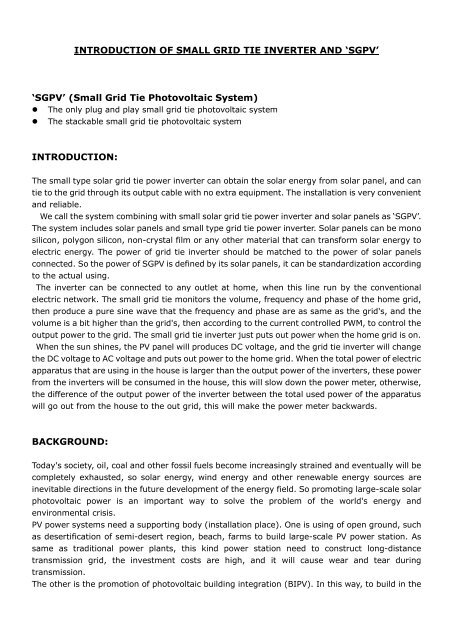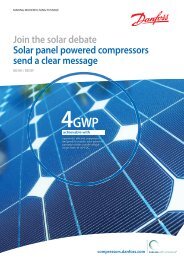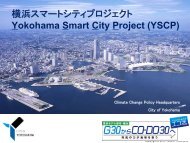INTRODUCTION OF SMALL GRID TIE INVERTER AND - Solar Panels
INTRODUCTION OF SMALL GRID TIE INVERTER AND - Solar Panels
INTRODUCTION OF SMALL GRID TIE INVERTER AND - Solar Panels
Create successful ePaper yourself
Turn your PDF publications into a flip-book with our unique Google optimized e-Paper software.
<strong>INTRODUCTION</strong> <strong>OF</strong> <strong>SMALL</strong> <strong>GRID</strong> <strong>TIE</strong> <strong>INVERTER</strong> <strong>AND</strong> ‘SGPV’<br />
‘SGPV’ (Small Grid Tie Photovoltaic System)<br />
• The only plug and play small grid tie photovoltaic system<br />
• The stackable small grid tie photovoltaic system<br />
<strong>INTRODUCTION</strong>:<br />
The small type solar grid tie power inverter can obtain the solar energy from solar panel, and can<br />
tie to the grid through its output cable with no extra equipment. The installation is very convenient<br />
and reliable.<br />
We call the system combining with small solar grid tie power inverter and solar panels as „SGPV‟.<br />
The system includes solar panels and small type grid tie power inverter. <strong>Solar</strong> panels can be mono<br />
silicon, polygon silicon, non-crystal film or any other material that can transform solar energy to<br />
electric energy. The power of grid tie inverter should be matched to the power of solar panels<br />
connected. So the power of SGPV is defined by its solar panels, it can be standardization according<br />
to the actual using.<br />
The inverter can be connected to any outlet at home, when this line run by the conventional<br />
electric network. The small grid tie monitors the volume, frequency and phase of the home grid,<br />
then produce a pure sine wave that the frequency and phase are as same as the grid's, and the<br />
volume is a bit higher than the grid's, then according to the current controlled PWM, to control the<br />
output power to the grid. The small grid tie inverter just puts out power when the home grid is on.<br />
When the sun shines, the PV panel will produces DC voltage, and the grid tie inverter will change<br />
the DC voltage to AC voltage and puts out power to the home grid. When the total power of electric<br />
apparatus that are using in the house is larger than the output power of the inverters, these power<br />
from the inverters will be consumed in the house, this will slow down the power meter, otherwise,<br />
the difference of the output power of the inverter between the total used power of the apparatus<br />
will go out from the house to the out grid, this will make the power meter backwards.<br />
BACKGROUND:<br />
Today's society, oil, coal and other fossil fuels become increasingly strained and eventually will be<br />
completely exhausted, so solar energy, wind energy and other renewable energy sources are<br />
inevitable directions in the future development of the energy field. So promoting large-scale solar<br />
photovoltaic power is an important way to solve the problem of the world's energy and<br />
environmental crisis.<br />
PV power systems need a supporting body (installation place). One is using of open ground, such<br />
as desertification of semi-desert region, beach, farms to build large-scale PV power station. As<br />
same as traditional power plants, this kind power station need to construct long-distance<br />
transmission grid, the investment costs are high, and it will cause wear and tear during<br />
transmission.<br />
The other is the promotion of photovoltaic building integration (BIPV). In this way, to build in the
PV power system with all types of buildings of the cities, make full use of the building walls,<br />
windows, sunshade and other resources to expand the area of a solar energy generating electricity<br />
system.<br />
"SOLAR RO<strong>OF</strong>S", it indicates to gather the solar energy from every home‟s roof. This initiates a<br />
new mode of clean renewable energy - "near production, local consumption". Both environmental<br />
protection and energy saving are realized, the land is conserved and the cost is reduced. It has<br />
now become a competition to encourage governments around the world to promote the new<br />
energy production methods.<br />
How to tie the “million solar roofs” to the grid is a great obstacle, and it is a key to promote the<br />
“<strong>Solar</strong> Roofs”. The SGPV is a powerful method to solve this obstacle.<br />
ADVANTAGE:<br />
There are many advantages of SGPV compare with the traditional grid tie system.<br />
1. Low cost and easy installation - SGPV can make full use of all types of buildings‟ surface that face<br />
to the sun in the city as well as fast and easy installation of solar modules and grid tie inverter. It's<br />
very low maintenance costs.<br />
2. Free combination - SGPV can be used as a separate grid tie system and can be setup as a large<br />
solar array with many of them. The quantity of SGPV in the array is just according to your desire.<br />
If you are planning to install a grid-tie PV system, in a general way, the solar array and inverter<br />
need to be carefully matched to ensure that the inverter‟s voltage and power limits are not<br />
exceeded. When you want to increase more solar panels, and if the total power of the solar panels<br />
exceeds the allocation grid inverter, it is necessary to increase the cost of a grid inverter.<br />
3. Combination of SGPV does not interact - The traditional solar grid tie system, they offer units<br />
ranging in high power output and these units are modular so you can have multiple units operating<br />
in parallel for large solar arrays. Although, the traditional grid inverter has MPPT feature (Maximum<br />
Power Point Tracking), but the maximum power point is according to the entire series in terms of<br />
solar panels array, if the performance of a piece of solar panels in the system, for some reason,<br />
such as leaves, bird droppings, dust, shadow, etc., degrades, the performance of the entire solar<br />
power system will decrease.<br />
SGPV has no such disadvantage. If the performance of a piece of solar panels in the system<br />
degrades, this just effects this piece itself, will not affect other SGPV in the system.<br />
4. Improving the efficiency of the entire solar power system – In traditional grid tie system, the<br />
solar panels are connected in series, so the MPPT of the inverter is according to the total panels in<br />
series, not to every panel, but there is difference between every panel, so not every panel is<br />
working at the maximum power, this will reduce the total power of these panel in series.<br />
But SGPV has no such disadvantage. Because every inverter of SGPV has MPPT function, so every<br />
panel is working at the maximum power, this will increase the efficiency of the entire system.<br />
5. Low power consumption – Most of the parts in the small grid-tie inverter are digital ICs and low<br />
power MCU, so the power consumption of it is low, though the quantity of grid tie inverters is<br />
increased, but this will not increase the power consumption of the entire system.
INSTALLATION :<br />
The individual system of SGPV is shown in Figure 1. Installing the solar panel of the SGPV at a<br />
suitable location that sunshine can irradiate on it, connecting the cables of the solar panel to the<br />
DC input terminals of the small grid tie inverter of the SGPV, inserting the plug of the inverter into<br />
the socket of the home grid. After this, when the sun shines, the SGPV will convert the solar energy<br />
to the home grid.<br />
Figure 1<br />
A SGPV<br />
SGPV can be stackable, and all SGPVs are independent each other. The total power converting to<br />
the grid is the total power of all SGPVs. The installation of each SGPV is same. Connecting large<br />
quantity of SGPV to the grid, this will construct high-power grid-tie system<br />
Operation Procedures:<br />
1, Please select a suitable AC output voltage grid tie inverter according to your location home grid<br />
AC voltage.<br />
2, Connect the <strong>Solar</strong> Panel or Wind Turbine‟s DC supply cables to the DC input terminal of the<br />
inverter, be sure that the polarity is correct. Recommended DC input cable size for maximum<br />
output is 8AWG or cables that can handle more than 30A. Optimal length would be less than 8m,<br />
longer cables will experience higher voltage drop. The range of output power of <strong>Solar</strong> Panel or Wind<br />
Turbine is 20W~500W.<br />
3, Connect the supplied AC power cord to the inverter and plug it to a home wall socket.<br />
4, The 3 green LED indicators will start to cycle from left to right when the grid and DC supply is<br />
detected. This indicates the inverter is operating under normal condition. The rate of the cycling is<br />
according to how much power is being output from the solar panels or the wind turbine. The more<br />
big output power is, the more fast the rate is. If there is no AC grid detected, the red LED will be<br />
on, the inverter will not put out power, this is called “Island Protection”.
Electrical Specifications:<br />
Model<br />
SUN-500G<br />
Normal AC Output Power<br />
450W<br />
Maximum AC Output Power<br />
500W<br />
AC Output 220V/230V/240V<br />
190V ~ 260V<br />
Voltage 110V/120V<br />
90V ~ 130V<br />
AC Output Frequency Range<br />
46Hz ~ 65Hz<br />
Total Harmonic Distortion(THD)





